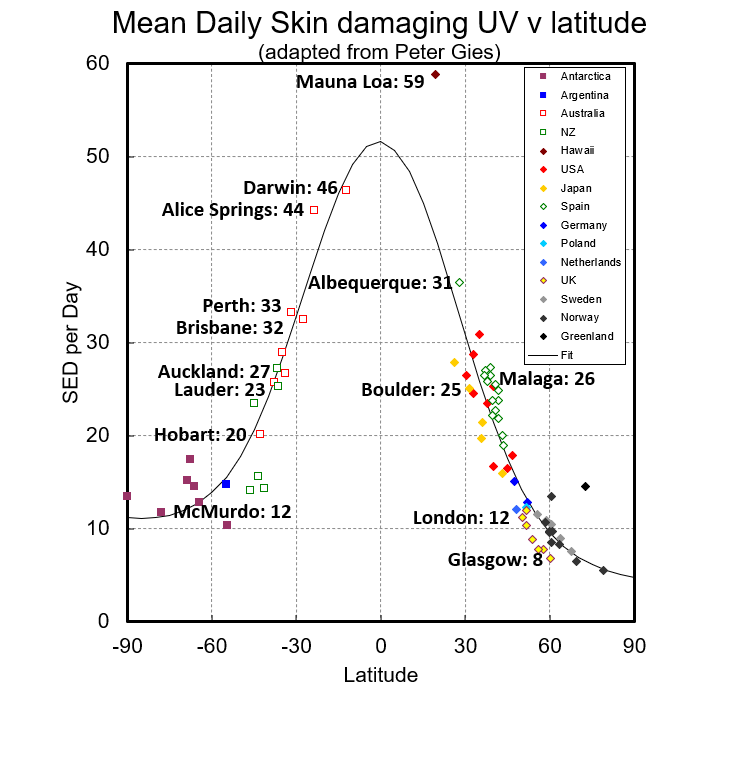It’s no surprise that skin cancer rates are so much worse for us ‘down under’ in Australia and New Zealand compared with the UK. Skin cancer is caused by exposure to UV radiation, and the amount available over the course of a year is much greater for us - mainly because we’re so much closer to the equator. The most ‘tropical’ parts of the British Isles are hundreds of kilometres further from the equator than any part of New Zealand.
The plot below shows some UV data that my Australian colleague Peter Gies collected from the literature and from several groups around the world more than a decade ago. I thought we were going to publish the results, but it seems we never got around to it. Though I do I see there is an earlier publication that seems to use much of the same data. In case some has never seen the light of day, I should mention the other contributors. They’re Weine Josefsson (Sweden), Andy Pearson (UK), Germar Bernhard (USA), M.P. Utrillas (Spain), and J. Krzyścin (Poland). And, of course, us.
Anyway, the plot shows the mean daily dose of measured sunburning UV as a function of latitude. The dose unit, SEDs/day, is an abbreviation for ‘Standard Erythemal Dose’, per day. For fair skinned people, visible skin damage (reddening) occurs after an exposure to about 2 SED. Measurements from individual sites are shown by the symbols, and the smooth line is a fit to the data. Data points lying below the curve are from sites that are cloudier than average, and points lying above the curve are from sites at high altitudes and over ice-covered surfaces with higher surface reflectances. Notice the skew towards higher values in the southern hemisphere. That’s due to the combined effects of our lower ozone amounts (especially in Antarctica), our closer Sun-Earth separation in summer, and our cleaner air.
As you can see, the average daily dose ranges from about 5 SED/day in the Arctic to nearly 60 SED/day at the high-altitude tropical Mauna Loa Observatory in Hawaii. At all sites shown the mean daily dose comfortably exceeds the 2 SED threshold for skin damage, and at Mauna Loa the mean dose exceeds that threshold by a factor of 30.
In the British Isles, the daily doses ranges from 8 SED in the north to 12 SED in the south, compared with those in New Zealand and Australia that can reach 27 and 46 SED respectively. That’s three to four times as much as the UK.
What about daily maximum doses? Within the tropics, any seasonal differences are small, but because of the strong seasonal variation in sun elevations and daylight hours at higher latitudes, the peak daily UV dose over a long summer day can exceed those averages by more than a factor of two, and by even more if we restrict to clear days. For example, at Lauder (45S), the mean daily dose is 23 SED, but the dose over a summer’s day can exceed 75 SED. We’ve measured similarly large daily doses at other mid-latitude sites, including Melbourne (70 SED) and Boulder (75 SED). Perhaps surprisingly, those daily maxima aren’t hugely less than those at tropical sites like Alice Springs and Mauna Loa (85 and 92 SED respectively).
In New Zealand and Australia, the age-standardised melanoma rate is about 35 cases per 100,000 people, just over twice than in the UK (15 cases per 100,000). For me, the only question is: why aren’t Australia’s rates much higher than New Zealand’s? I can think of a couple of possibilities. It may a behavioural effect relating to Australia’s much higher temperatures, which makes it less comfortable to be out in the sun. Or, it may be a genetic effects, with a smaller proportion of it’s population of the most at-risk Celtic descent.
Interestingly, dose rates in the USA (14 cases per 100,000) are similar to those in the UK, despite their much higher UV doses which range from about 15 to 30 SED/day. Although most of the population live at the lower end of that range, it does seem surprising that their rates aren’t closer to ours. Perhaps it’s because they spend more indoors time watching screens 😊.
Here down-under, our outdoor lifestyle and our “she’ll be right attitude” are no doubt contributing factors to our higher rates.
The latter is easily fixed. Use sunscreen and protect yourself!




And maybe Smart Band!